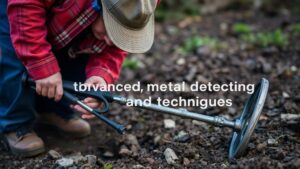Advanced Methods for Identifying Non-Metallic Relics Near Metal Signals
Advanced Methods for Identifying Non-Metallic Relics Near Metal Signals
The continued growth of archaeological exploration in various terrains has brought forth the need for advanced identification techniques, especially when it comes to non-metallic relics in proximity to metal signals. In archaeology, distinguishing between these objects is crucial as it informs both the understanding of historical contexts and the methodologies employed during excavations. This article delves into sophisticated techniques employed to identify non-metallic relics amidst metallic signals, highlighting technologies and exploratory methods that minimize inaccurate detections.
The Dilemma of Metallic Signals
Archaeologists frequently face challenges posed by metallic signals generated by various detectors. e signals can mask or overshadow non-metallic objects such as ceramic, stone, or bone relics. For example, a metal detector may generate a strong response from nearby iron-rich soil or metallic artifacts, leading to potential misidentifications. Understanding how these signals operate is fundamental to implementing advanced identification methods.
- Metal detectors can operate based on electromagnetic induction or pulse induction, each producing specific interference patterns.
- Signal attenuation can occur based on the types of surrounding materials and their electromagnetic properties.
Utilizing Multi-Frequency Detectors
Multi-frequency metal detectors can effectively isolate non-metallic materials by operating at various frequencies simultaneously. Different frequencies can penetrate diverse materials with varying efficiency, allowing archaeologists to differentiate signals based on the resonant characteristics of both metallic and non-metallic objects.
A notable case study involved the use of multi-frequency detectors in the excavation of a medieval site in England. Archaeologists found that by monitoring signal responses from lower frequencies, they could reduce interference from metallic signals, leading them to identify well-preserved pottery shards without disturbance.
Ground Penetrating Radar (GPR)
Ground Penetrating Radar provides a non-invasive method to detect sub-surface features, making it a valuable tool in identifying non-metallic relics. GPR utilizes radar pulses to image the subsurface structures and can differentiate between materials based on their dielectric properties.
In a field survey conducted in 2020 at a prehistoric settlement in the Midwest United States, GPR was utilized to identify a series of elongated features interpreted as ancient storage pits. non-metallic artifacts found in proximity to these signals corroborated the GPR findings, showcasing the method’s efficacy in revealing nuanced archaeological contexts.
Magnetometry
Magnetometry is another powerful method for identifying non-metallic relics in areas with metallic noise. This technique measures variations in the Earth’s magnetic field caused by subsurface features. While primarily used to identify ferrous objects, it can also locate areas with thermal anomalies indicative of archaeological interest, such as fired clay or burnt organic remains.
A practical application of magnetometry was observed during the excavation of a Roman villa in Italy. survey successfully revealed a series of walls and hearths, which led to a focused investigational effort on areas indicated by magnetic anomalies, yielding significant finds despite nearby metallic distractions.
Signal Filter Algorithms and Machine Learning
The advent of digital computing has allowed for the development of advanced signal filter algorithms that can process and analyze data emitted from metal detectors. These algorithms enhance the capability to recognize non-metallic signals distinct from metallic ones through supervised learning techniques.
- Machine learning tools can be trained with vast amounts of data from different excavational contexts to recognize unique signatures associated with non-metallic artifacts.
- Algorithms can adapt to specific soil compositions and types of outlines found in various archaeological settings, leading to increased accuracy in relic identification.
Future Innovations and Trends
The progression in detecting techniques signals an exciting future for archeologists. The fusion of geophysical methods with machine learning capabilities seems particularly promising. As detectors become more sensitive and computational techniques advance, the potential false positives from metal signals can be drastically reduced.
Innovations such as autonomous drone surveys equipped with multispectral imaging may also assist in scanning areas that are otherwise difficult to access while simultaneously providing data on potential metal and non-metal signals. Combining these methods can streamline the excavation process and enhance the accuracy of findings.
Actionable Takeaways
In summary, navigating the complexities of identifying non-metallic relics in the presence of metallic signals requires a combination of advanced techniques. Archaeologists are encouraged to:
- Adopt multi-frequency detectors for versatile signal detection.
- Employ GPR to visualize subsurface features without excavation.
- Use magnetometry to place non-metallic artifacts in context.
- Incorporate machine learning algorithms to improve signal processing.
By leveraging these innovative methods, archaeologists can enhance their understanding of the past while minimizing errors associated with metallic interferences.

